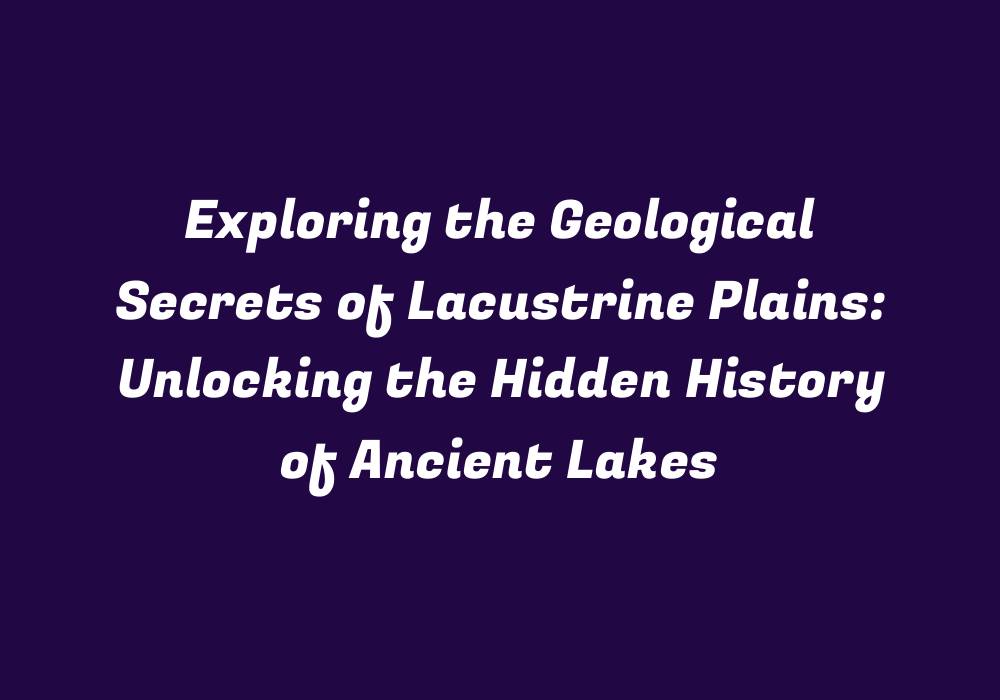Introduction
Lacustrine plains are vast, flat expanses that lie around the edges of lakes and can cover significant land areas. These unique geological features have intrigued scientists for centuries, as they hold a wealth of information about Earth’s history and evolution. In this article, we will explore the geological secrets hidden within lacustrine plains, focusing on their significance in revealing the hidden history of ancient lakes.
Formation Processes
Lacustrine plains form when a lake’s water level drops or remains stagnant for an extended period. As the water evaporates and sediments accumulate, the lake’s catchment area gradually expands, leading to the formation of these extensive, low-lying land areas. This process can take tens of thousands of years, during which various factors interact, shaping the distinctive geological features found in lacustrine plains.
Geological Composition
The composition of lacustrine plains varies greatly depending on their location and the specific environment in which they form. Commonly, they are composed of a mixture of silts, clays, fine-grained sediments, and other weathering materials derived from the surrounding landscape. These sediments can be rich in minerals, fossils, and chemical elements that have been dissolved in the lake’s waters over time.
Climate Change Impact
Lacustrine plains often act as a sensitive indicator of climate change, reflecting fluctuations in temperature, precipitation, and water levels. They can preserve evidence of past climatic events that might otherwise be lost or hard to detect. For instance, researchers have found that lacustrine plain deposits from the last glacial period (about 10,000 years ago) offer valuable insights into how Earth’s climate has evolved since then and how it might change in the future.
Paleontological Studies
Lacustrine plains hold a wealth of information for paleontologists interested in studying ancient life. The fine-grained sediments that accumulate over time can preserve fossil remains, offering unique glimpses into the evolution and distribution of plant and animal species from different geological periods. By analyzing these fossils, scientists have been able to reconstruct past ecosystems, better understand how climate change affected biodiversity, and even investigate the origin and dispersal of various species throughout Earth’s history.
Hydrogeological Studies
Lacustrine plains can act as natural water reservoirs, storing and releasing groundwater that seeps into their porous sediments over time. As a result, they play a crucial role in regional hydrology, influencing the availability of freshwater resources for human settlements and ecosystems. By studying the interactions between lacustrine plains and surrounding water systems, researchers can better understand how to manage water resources sustainably.
Agricultural Implications
The fertile nature of many lacustrine plain deposits makes them an ideal location for agriculture. Ancient civilizations often settled near these land areas due to their rich soil, which provided abundant food resources and allowed for the cultivation of various crops. Today, agricultural communities across the globe still utilize lacustrine plains for crop production and grazing, highlighting the continued importance of these geological features in supporting human life.
Conservation Efforts
As our knowledge of lacustrine plain deposits grows, it becomes increasingly crucial to preserve these unique environments. Many efforts are currently underway to protect and restore these areas by limiting human interference, implementing sustainable agricultural practices, and promoting responsible resource management. By doing so, we can ensure the continued existence of this valuable natural heritage for future generations to explore and learn from.
Conclusion
Lacustrine plains hold a wealth of information about Earth’s past that has yet to be fully uncovered. These geological formations have evolved over thousands of years, capturing the essence of climate change, human settlements, and the evolution of life on our planet. By studying lacustrine plain deposits in greater depth and incorporating them into our understanding of Earth’s history, we can unlock further insights into our planet’s rich and complex past.
